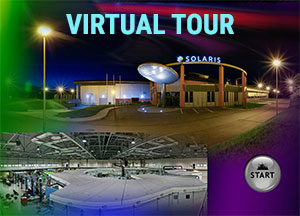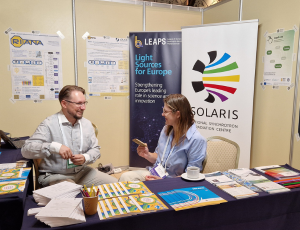 Web Content Display
Web Content Display
SOLARIS centre
 Web Content Display
Web Content Display
75th Anniversary of the 1st observation of synchrotron light
On April 24, 2022, we are celebrating the 75th anniversary of the first synchrotron light observation. To celebrate the special day, we go back in time to the beginnings of the Solaris Synchrotron to recall those exciting moments and milestones in the development of the Centre. Speaking Dr Adriana Wawrzyniak, deputy accelerator director working at NCPS Solaris from the very beginning, that is, from 2009.
Kinga Wrobel: The Solaris Centre is a relatively young synchrotron, but even in such a short time a lot has been achieved. Certainly, one of the breakthrough moments for the Solaris Centre was the obtaining of the first synchrotron light. Could you please tell me more about the first steps of Solaris?
Adriana Wawrzyniak: The scientific community in Krakow has been making efforts to build a synchrotron in Poland for several years. As a result of these efforts, in 2009 it was possible to obtain financing to start construction of the largest multidisciplinary infrastructure in the country. The first years were devoted to the design of the synchrotron, which was carried out thanks to the unique cooperation with Swedish scientists from the MAXIV-Lab Centre in Lund. At the same time, design and execution work was underway for the building and the entire technical infrastructure in Krakow. I would like to add that in parallel with the design and construction works of the centre, a scientific, engineering, and technical team was formed gaining expert knowledge in the field of accelerator technologies during this time. In spring 2014, when the building was ready to use, the accelerator installation process began. The installation took a year, and we started its commissioning in May 2015. The start-up time was a particularly exciting and extraordinary moment: first electrons in the ring, ramping to full energy, and the first light observed on the fluorescent monitor in summer 2015. It aroused great enthusiasm among all the Solaris team and was the culmination of several years of hard work.
KW: Exciting, first synchrotron light observed in Krakow. What happened next? Tell us more about the construction of the first beamlines and, therefore, the appearance of users. Do you remember that pivotal moment for the Solaris Centre?
AW: The first beamlines were constructed in parallel with the storage ring commissioning and optimization of the electron beam. The first beamline built on a bending magnet was equipped with two end stations: a photoemission electron microscope (PEEM) and a universal station for studying X-ray absorption spectra (XAS). In the summer of 2015, the APPLE II undulator was installed in the storage ring as a photon source for the second beamline, UARPES. The installation and commissioning process of both lines was tedious and demanding due to the resulting technical problems and, therefore, lasted over 3 years. However, already in the spring of 2018, we welcomed the first befriended research groups that helped us optimize the lines and their key parameters, and then from October we started accepting external users from the first open call. It was a long-awaited moment at SOLARIS, for which we were preparing a lot, also in terms of source management. The operating and beam-sharing procedures have been developed to fully satisfy the scientists, and in retrospect, I must say that we did quite well.
KW: Let us fast forward to the present day. What are the challenges that Solaris Centre is facing today and what is the next milestone for Solaris synchrotron?
AW: Currently, Solaris is a research centre that accepts external users, but at the same time, it is still in the intensive development phase. In the near future, other important milestones are the expansion of the experimental hall and the launch of new experimental beamlines, which will enrich the centre's research offer. In addition, in the longer term, work is planned to upgrade the linear accelerator to the full energy of 1.5 GeV and change the operating mode of the storage ring from the decaying to the top-up mode.

Photo: Joanna Kowalik. In the photo Dr. Adriana Wawrzyniak, Accelerators Deputy Director.



